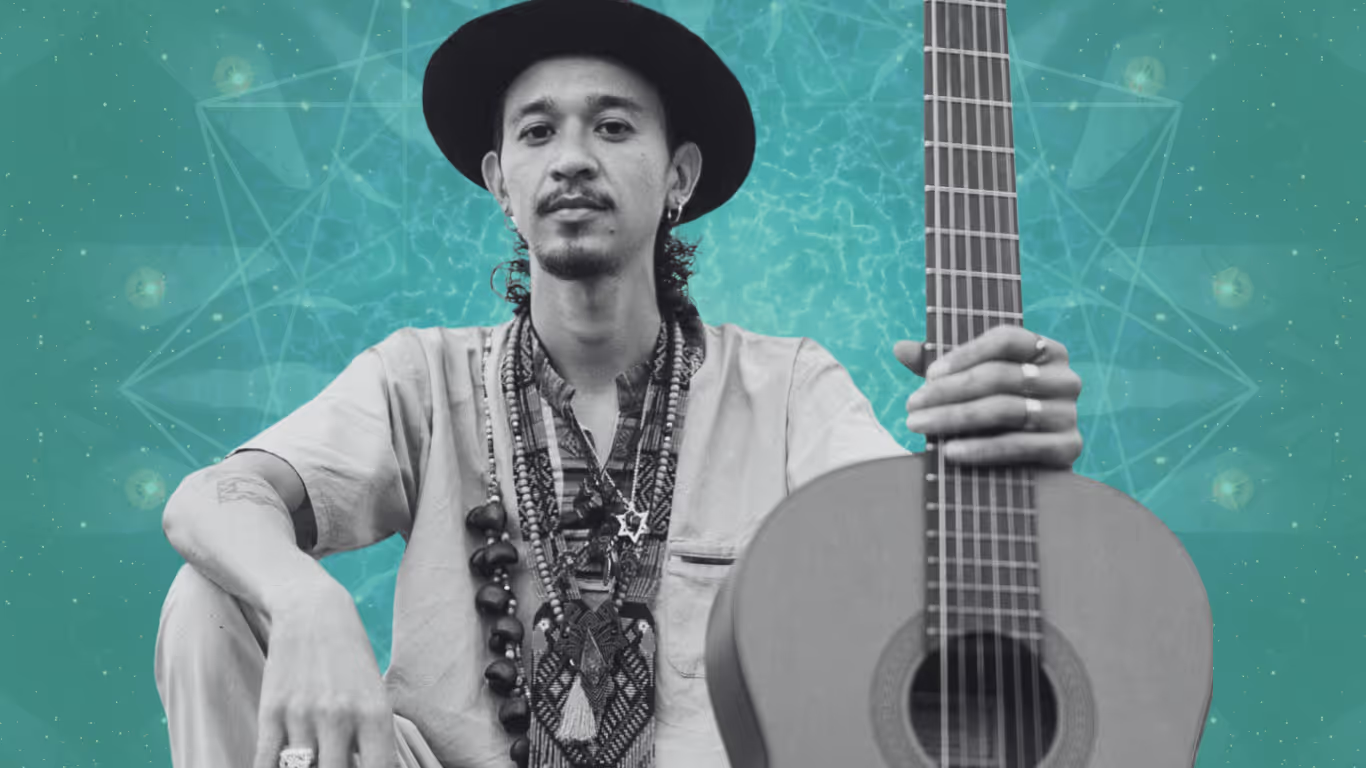The Role of Music in the Psychedelic Experience


Music has long been recognized as a powerful catalyst for altering consciousness and enhancing various experiences. Since time immemorial, shamans, medicine men and women and artists used sound to invoke changes in people’s consciousness. Whether rooted in the therapeutic or the artistic, music has been part of the human experience since the very early days: in Slovenia, archeologists have found a flute carved out of the femur of a cave bear, produced more than fifty or even sixty thousand years ago. We can picture Siberian shamans banging drums made with the skin of the elk; Sumerian priests invoking the sounds of the lyre, and the hypnotic rumble of the didgeridoo played by the indigenous people of Australia. Music and expanded states of consciousness go and hand; and in fact, many of the shamanic practices found around the world rely on music rather that pharmacology. Techniques of ecstatic trance, induced by repetitive music, singing or dancing, are widespread and find in many traditional cultures around the world. Among the various psychedelic traditions —those mystical or ecstatic traditions that do incorporate the use of psychedelic plants, fungi, or substances— the use of ayahuasca stands out for its unique integration of music, especially through the ikaros—sacred songs sung by shamans before, during and after an ayahuasca ceremony. This blogpost explores the profound role of music in the psychedelic experience, with a focus on the ayahuasca traditions and the unique phenomenon of the ikaro, examining their origins, functions, and impact on participants.
What is an Ikaro?
The term “ikaro” is derived from the Quechua word “ikaray,” meaning “to blow smoke for healing purposes.” With the passage of time and the cultural hybridization typical to shamanism, the term has come to mostly refer to the sacred songs used in ayahuasca ceremonies. The origins of the ikaro are deeply rooted in the traditions of the indigenous peoples of the Amazon, both in the high andes and the rainforest lowlands. People who perform the social role of the “shaman”, known in Spanish as curanderos, vegetalistas or ayahuasqueros, learn these songs through years of apprenticeship and spiritual practice. While some ikaro can be learned from human teachers, the melodies and lyrics are often said to be received during the visionary state induced by ayahuasca itself, making them a direct gift of the plant medicine. Curanderos will diet a plant — meaning, they will go into isolation for prolonged periods of time, eating little and doing even less, with the sole purpose of connecting the the “mother” or the spirit of a particular plant or tree, who may then choose to teach the dietador their melody and song.
In the indigenous cultures of South America, Ikaros are considered to be much more than just songs; they are viewed as powerful spiritual tools that have the ability to influence subtle energies and invoke spirits encountered during the ayahuasca journey. Each ikaro —and often different parts within the same ikaro— has a specific purpose, such as clearing obstructing energies, re-arranging subtle energetic patterns, calling in protective spirits, evoking cathartic emotions or purges and guiding participants through difficult moments. The shaman uses these songs to create a safe and structured environment, as it were —the song is part of the setting, gives us something to anchor our breath to. The ikaro is the main tool we have, together with our own breath, as we navigate the often intense and challenging experiences brought about by the brew. In the following section, we will see some of the main and most important ways in which ikaros enhance and support the healer and the participants during an ayahuasca ceremony.
How Do the Ikaros Work ?
One of the primary roles the ikaro play in ceremony is to guide participants through the psychedelic experience. The non-ordinary state induced by ayahuasca can be, at times, overwhelming and disorienting. Ikaros act as auditory anchors, providing a sense of direction and focus. Furthermore, a skilled shaman can use the melodies to lead participants through different phases of the journey, from the initial onset of the brew’s effects to the peak experience and the gradual return to normal consciousness. Skilled practitioners know how different sounds, rhythms, frequencies and cadences impact the inner experience of the participant, and they can sing to help steer the wheel and make sure that navigation stays on course.
Ikaros are believed to have powerful healing properties. In fact, in many ayahuasca traditions, the main medicine is not the brew itself, but the song. The curandero’s toolkit is wide, and the ikaro is front and center. The curandero sings to cleanse negative energies, expel spiritual intrusions, and facilitate emotional and physical healing. An ikaro can often times exacerbate nausea to bring forth a brewing purge, or send us running to the bathroom. Participants often report experiencing intense emotional release and profound insights during the singing of particular ikaros. The melodies and rhythms, provided to the shaman by the plants themselves, are perceived to resonate with the vibrational frequencies of the human body, thus promoting harmony and balance.
In the shamanic worldviews of the amazon rainforest, ayahuasca is said to be a bridge to the spiritual realms. These are not supernatural realms — but overlapping dimensions of existence that our brains filter out in the day to day. Ikaros are considered to be a common language — a means of communication with the different forms of consciousness that inhabit our world, many of whom remain hidden behind the veil of sensory perception. These may include the mothers or spirits of the plants, animals, natural features such as rivers, mountains, or storms, ancestors, and other entities with whom we share life. The songs are used to invoke these entities, seek their guidance, and request their assistance in the healing process. The shaman acts as an intermediary, using the ikaros to bridge the gap between the physical and spiritual worlds.
The ceremonial space, we know, is a sacred environment where participants can undergo deep personal and spiritual transformation. Ikaros play a crucial role in creating and maintaining this space. With the help of the Ikaro, the shaman sets the intention for the ceremony, creates and maintains protective boundaries, and curates a harmonious atmosphere. Last, but not least, the ikaros play a cohesive role: their rhythmic and melodic structure help synchronize the energy of the group, nurturing a sense of togetherness and enhancing the collective experience.
The Effects of the Ikaros During Ceremony
Going a little deeper into the the impact that ikaros can have during ceremony, we must first start with a disclaimer: while ikaros can have profound effects on our ceremony, experiences can be different for each person. No two ikaros are alike, and no two people are alike. An ikaro is a work of art in real time; it is tailored to the moment and the person, and in that sense, each ikaro is unique. Not only is each melody unique, but each time that the melody is sung is unique. No two ikaros are ever alike. So while the singing enhances the overall experience, influencing the emotional, psychological, and spiritual dimensions of the journey, the ikaro is a tool that requires a skilled and committed practitioner who knows how to use it.
As we shared above, Ikaros often evoke strong emotional responses. The melodies and rhythms can elicit feelings of joy, sorrow, fear, and love, sometimes all within a single ceremony. A skilled practitioner may be able to see what the participant needs, and sing accordingly. During ceremony, people often report experiencing cathartic emotional releases, as the music helps them access and process deep-seated emotions. This emotional resonance is a crucial aspect of the healing process, allowing us to become aware of, confront and integrate unresolved issues that may still carry emotional weight.
Ayahuasca is known for its powerful perceptual effects, what some people call “visions”, and others call “hallucinations”. We prefer the term “visions”, since the visionary state better describes what this experiences truly are. The outdated term “hallucination”, however, implies an error, a mistake of perception, and is often used in a pathologizing way that diminishes from the value and meaning of the experience itself. The visionary state is not exclusively “visual” — it often includes visual input as well as auditory, tactile, emotional and other forms of information. The visionary experience often includes intricate and colorful visions, but the point of it is not to merely contemplate beauty or get lost in the novelty, but rather, to reflect on what the experience is teaching us about ourselves and the world around us. One of the main purposes of the Ikaros is to amplify and shape these visual and otherwise perceptual experiences. The interplay between the music and the visions can create a synesthetic effect, where participants perceive colors, shapes, scents, textures, and movements in response to the sound of the ikaros. This multi-sensory experience can be both awe-inspiring and therapeutic, and a skilled practitioner can help guide us through the visionary state safely.
Beyond the visionary state, ceremony can gifts us profound spiritual insights and allow us to experience mystical states. Ikaros are believed to facilitate these experiences by opening channels of communication with the spiritual realms, and acting as a bridge between the human participants and the rest of the spiritual entities with whom we share space. Remember — these tools and practices are part of animistic cultures where these ideas are common place. Whether this is something that we relate to or not — thats okay. Everybody can have their own interpretation and make sense of their own experience without the need to adopt new beliefs. Regardless of what our worldview is like, however, the ikaros can induce a sense of connection to something greater than ourselves, whether it be the spirit of the plants, humanity as a whole, the natural world, or the divine. These experiences often lead to lasting changes in worldview, personal values, and sense of purpose — providing us with a wider, more holistic view of the world we live in.
Lastly, ikaros can be helpful for he integration of the ayahuasca experience into daily life —a critical aspect of the healing process, that we talk about in depth in a another blogpost. Ikaros can play a significant role in this integration, as they linger in our memory serving as reminders of the insights and lessons gained during the ceremony, and the retreat experience as a whole. Listening to recordings of ikaros, recalling the melodies or humming the tunes can help us reconnect with the experience, facilitating ongoing reflection and personal growth.
What Does the Research Say?
Recent scientific research has begun to explore the interplay between music and psychedelics, providing insights into the mechanisms underlying their combined effects. Studies using neuroimaging techniques have shown that both music and psychedelics can enhance connectivity between different brain regions, leading to a more integrated and flexible state of consciousness. This enhanced connectivity is thought to underlie the profound emotional and cognitive experiences reported by participants.
For example, a study published in Psychopharmacology by Kaelen et al. (2018), aptly titled “The hidden therapist: Evidence for a central role of music in psychedelic therapy”, specifically investigated the effects of music on the psychedelic experience induced by psilocybin, a compound similar to DMT— the main psychoactive tryptamine found in the ayahuasca brew. The researchers found that music significantly enhanced the emotional and mystical aspects of the experience, leading to deeper therapeutic outcomes. Although this study focused on psilocybin, the findings are relevant to ayahuasca, as both substances interact with the brain’s serotonin receptors and produce somewhat similar altered non-ordinary states of consciousness.
The scientific study of ayahuasca and ikaros is still in its early stages, but plenty of anecdotal and observational data suggest that the combination of music and psychedelics creates a unique and powerful therapeutic environment. Future research could further elucidate the specific neural and psychological mechanisms by which ikaros influence the ayahuasca experience, but, of course, like anything any experience that is highly subjective and ineffable, the proof is in the pudding! You have to experience this yourself to be able to make your own assessment
Conclusion
The role of music in the psychedelic experience, particularly through the ikaros of ayahuasca ceremonies, is profound and encompasses almost every aspect of the experience. From grounding and anchoring, to protecting the space, navigating non-ordinary states and evoking or amplifying emotional states, ikaros serve as maps, medicines, and bridges to the spiritual realm, shaping and enhancing the emotional, psychological, and spiritual dimensions of the ayahuasca journey. The interplay between music and psychedelics helps curate a powerful therapeutic and visionary environment that can structure and support experiences of deep healing, personal transformation, and mystical exploration. But don’t let us just tell you all about it — this is truly the kind of synergistic, emergent magic that needs to be experienced to be truly understood.
Take the next step
Ready for your life-changing journey?

Transform Depression with Ayahuasca
Watch this educational webinar to explore the therapeutic potential of Ayahuasca in treating depression with Dr. Jeff McNairy and Dr. Mariana Rojas.
Here's what you'll learn in this discussion:
- How people and their brains get stuck in depression
- How Ayahuasca resets the brain of people dealing with depression
- How the Rythmia Way Program helps people reset their lives





.avif)
